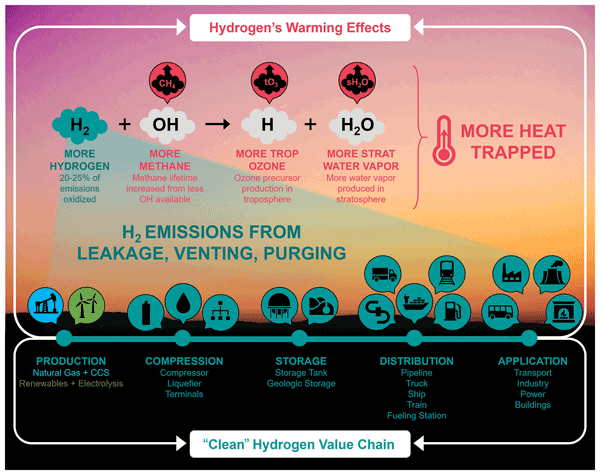Hydrogen Hype's Physics Problem
 The Biden administration is spending billions on the National Clean Hydrogen Strategy, even recently celebrating Hydrogen Day on October 8 (because hydrogen’s atomic weight is 1.008) to “mark a symbolic opportunity to celebrate hydrogen—clean hydrogen, specifically—and the crucial role this element plays in supporting a robust, equitable clean energy future for all Americans.”
The Biden administration is spending billions on the National Clean Hydrogen Strategy, even recently celebrating Hydrogen Day on October 8 (because hydrogen’s atomic weight is 1.008) to “mark a symbolic opportunity to celebrate hydrogen—clean hydrogen, specifically—and the crucial role this element plays in supporting a robust, equitable clean energy future for all Americans.”
“There’s a lot to like about hydrogen as a fuel source, climate journalists such as David Gelles gush.
The only problem is that “clean hydrogen,” also known as “green hydrogen”—that is, hydrogen gas generated using renewable electricity—isn’t particularly “clean” or “green,” although it’s less polluting than “gray” and “blue” hydrogen, produced from natural gas.
Unfortunately, even “green” hydrogen is a powerful greenhouse pollutant.
As an important paper from Environmental Defense Fund scientists Ilissa Ocko and Steven Hamburg explains, hydrogen is unavoidably leaky, because it’s such a small molecule, and like methane, has a high short-term warming effect. In fact, one of hydrogen’s main warming effects is to increase the atmospheric lifetime of methane. Methane breaks down in contact with the hydroxyl (OH) radical formed when ultraviolet light interacts with ozone (O₃) and water vapor (H₂O). Hydroxyl also reacts with hydrogen molecules (H₂), so significant hydrogen pollution means atmospheric methane doesn’t break down. Thus, Ocko and Hamburg find:
Hydrogen’s 100-year greenhouse warming potential (GWP) is twice as high as previously thought, and its 20-year GWP is 3 times higher than its 100-year GWP. Hydrogen’s maximum GWP occurs around 7 years after the initial pulse of emissions, with a range of 25 to 60 based on uncertainties, and a central estimate of 40.
In short, “green” hydrogen isn’t.
"Clean" Hydrogen
The purpose of the hearing is to examine the opportunities and challenges in using “clean” hydrogen in the transportation, utility, industrial, commercial, and residential sectors.
Witnesses:- Dr. Sunita Satyapal, Director, Hydrogen and Fuel Cell Technologies Office, Hydrogen Program Coordinator, U.S. Department of Energy
- Dr. Glen Richard Murrell, Executive Director, Wyoming Energy Authority
- Mike Fowler, Director, Advanced Energy Technology Research, Clean Air Task Force
- Michael J. Graff, Chairman & Chief Executive Officer, American Air Liquide Holdings, Inc.
- Brian Hlavinka, Vice President, New Energy Ventures, Corporate Strategic Development, Williams
Hydrogen Road Tour 1
BMW, Daimler, GM, Honda, Hyundai-Kia, Nissan, Toyota, and VW will showcase their latest hydrogen vehicles. Rides will also be available from 12 – 3pm.
The Hydrogen Road Tour is a two-week trip across the U.S. with more than 30 planned stops beginning on August 11 to showcase clean, efficient, hydrogen powered cars. The tour, organized by the U.S. Department of Transportation, U.S. Department of Energy, National Hydrogen Association, and California Fuel Cell Partnership, seeks to highlight progress made with the development of hydrogen vehicle and fueling technologies. Hydrogen, in addition to biofuels and hybrids, is one of many options that can play an important role in our future energy portfolio. Among these options, hydrogen can make the greatest long-term impact on reducing pollution and fuel imports from vehicles.
999 Independence Avenue SW, Washington, DC 20024. (Between 9th ST and 12th ST SW, across from the DOE Forrestal Building and in front of the Smithsonian Castle).